My American History Tour: Boston Tea Party Museum and Saratoga Battlefield
It’s only treason if you lose. But did the Americans actually commit treason since the monarchy violated our natural rights?1
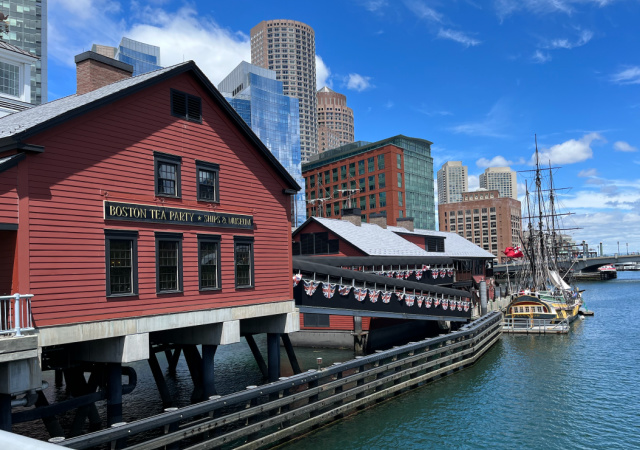
(Sorry the post is late! This trip is so hectic and tiring, especially now that I’m on the road again!)
Well, Saturday morning started out not so wonderful. I hoped for a relaxing breakfast with my cousin but I discovered my car was gone. Turns out the last parking spot does not belong to the AirBnB building I used so my car got towed. Instead, my cousin and I spent the morning finding an ATM and getting my car. Thank God it wasn’t stolen or destroyed.
ANYWAY! It went by fast and I still got to spend time with my cousin. It was an adventure!
Boston Tea Party Museum
On December 16, 1773, “The single most important event leading to the American Revolution” happened in Boston, MA.
The Boston Tea Party.
How does one go to Boston and not engage in a tea party? Especially a treasonous tea party! The whole experience made me wonder, again, what has happened to Americans? Not enough people get mad when the government instills a new tax or raises our taxes.
We allow the TSA to search and seize our items every day. The government restricts what kind of arms I’m allowed to bear. It’s disgusting.
The tea ship Dartmouth docked at Boston Harbor in late November.
Samuel Adams (bless his soul!) led a meeting at the Old South Meeting House urging his fellow colonists to take a stand against the Tea Act.
The law stated that ships must unload their cargo and pay duties within twenty days of docking or else customs officials confiscate the materials.
The meeting concluded that the colonists would persuade the Dartmouth captain to send the ship back without paying duties while others would patrol the ship to make sure no one would unload the tea.
Governor Hutchinson refused to allow the Dartmouth to leave without paying. The ships Eleanor and Beaver joined Dartmouth in the harbor.
The Boston Tea Party Museum puts you in the moment. The people dress up for the times as people who participated in the Tea Party. The best part was seeing little kids picking up the bushels carrying the tea and throwing it overboard.
SWEET DELICIOUS TREASON! But it’s only treason if you lose. Then again, if it’s the right thing to do, is it really treason? Did these men actually commit treason? In the eyes of King George III, they did but he doesn’t count.
You start in the Meeting House where Samuel Adams pumps you up to throw the tea into the harbor, similar to what Adams did at the Old South Meeting House.
On the Dartmouth’s last day Hutchinson refused once again to allow the ships to leave without paying the duty. At another meeting at the Old South Meeting House Adams was like, “OH, IT’S ON.” The people wanted to leave right away. Adams tried but failed to keep them from bursting out the door because the meeting wasn’t over.
The men donned disguises, went to the harbor, and had the best damn tea party in history!
Then you storm a replica ship that carried the tea. Three vessels. Three hours. Over 342 chests of tea were thrown into the water.
92,000 pounds of tea worth $1.7 million in today’s money. Everyone had a chance to throw a chest of tea into the water. It was so much fun.
You get chills when you go inside and view the Robinson Tea Chest. It is the only known chest from the Tea Party that survived. 15-year-old John Robison discovered the tea chest on the shore the day after the Tea Party. His family hid the box during the Revolutionary War.
After the war, the Robinsons took it out and passed it down through the generations. It’s fascinating history. One child used it like a dollhouse. Another person painted flowers on the side. They ever used it to house a litter of cats! You can read about it here. What a treasure!
I teared up watching the short movie about the Minute Men at Lexington-Concord. I wrote about that battlefield in a previous post. Only 16 months after the Tea Party the shot heard around the world happened as the Minute Men protected their areas against the Redcoats.
Freedom. Sweet freedom. I hate how we take our freedoms and Constitution for granted.
Saratoga Battlefield
I lost my Saratoga brochure, which helps me identify all my pictures and provide you guys with as much information as possible. Or it’s buried in my car. So bear with me here as I tell you about gorgeous Saratoga.
The 10-mile self-guided auto tour has 10 stops. A lot of the sites are under construction to make them ACA compliant. I hated that (I mean it’s a cool thing BUT STILL) because Saratoga is on par with Shiloh. It’s isolated and the spots are on a one way driving path with plenty of parking spots. It makes it so much more enjoyable (LOOKING AT YOU, GUILFORD COURTHOUSE!). The scenery…breathtaking.
It was also cold and rainy. But man, make Saratoga a top destination!
The visitor center has items found on the battlefield.
The Battle of Saratoga took place between September 18 and October 7, 1777. The main fighting happened on September 19 and October 7.
You could consider it the turning point of the Revolutionary War because it proved to the British that they cannot beat us. It also brought in foreign help to beat the Redcoats. The British already had German soldiers fighting with them. We still kicked their butts!
The Continental Army defeated British General John Burgoyne. He helped “invade” America by going through Canada, but was a tad slow. However, he retook Fort Ticonderoga from the Americans but by then we had already taken all the Redcoats’ ammunition and equipment. THANK YOU, ETHAN ALLEN.
But Burgoyne lost a lot of men at the Battle of Bennington. This would hurt him in Saratoga.
The first two spots I could not reach due to construction: Freeman Farm Overlook and Neilson Farm.
Freeman Farm belonged to loyalist John Freeman, who went and joined the British forces. A lot of the fighting on September 19 took place on his farm. Col. Daniel Morgan, a man in charge of 500 Virginia riflemen, opened fire on the Redcoats and pushed against Burgoyne at the Freeman House. American commander Horatio Gates sent in fresh reinforcements for Morgan, which helped slow down the Redcoats.
The park service restored John Neilson’s farm to look like it did when Benedict Arnold (not yet a traitor) and brigadier general Enoch Poor used it for their headquarters. Guys, Enoch Poor in unappreciated. We don’t hear a lot about him. I found this fantastic website with a lot of information about him.
Here we have stop #3, which shows the American River Fortifications. Volunteer Col. Tadeusz Kosciuszko, a Polish military engineer, helped design the fortifications. It helped stave off Burgoyne at this crucial point by blocking the Hudson Valley route to Albany.
Next up is Chatfield Farm, which belonged to Jesse Chatfield. Unfortunately for the Chatfield family, the Americans and Redcoats set up their lines by the farm between September 19 and October 7. They exchanged fire on this farm between the battles. Only a ravine separated them.
I couldn’t get pictures of the next three stops: Barber Wheatfield, Balcarres Redoubt (Freeman Farm), and Breymann Redoubt.
The Redcoats set up shop on the Barber Wheatfield but quickly ran out of materials and food. They tried to find a weakness on the American line so they could go to Albany but the Americans found them first.
The Redcoats retreated and the Americans grabbed their cannons and wheat.
The Redcoats found refuge at the Balcarres Redoubt on the Freeman Farm after the Americans bombarded them on Barber Wheatfield. They were able to keep the Americans away from this part.
Blah, I wish I could get to the Breymann Redoubt because this was a great win for the Americans. The Redcoats went to the Balcarres Redoubt but the German officers with them went to the Breymann Redoubt. The fortifications they built at this redoubt did nothing to stop the Americans.
The field in this next picture is where Burgoyne had his headquarters. This is where the majority of the Redcoats ate, slept, and regrouped. It’s where the majority of them lived in between the battles.
Humbug. I could not get pictures of the Great Redoubt. It’s the better of the British earth made forts at Saratoga. This one also had the British hospital and Loyalist camps.
I also couldn’t get to the Frasier Burial Site and Trail. It’s where the Redcoats buried British General Simon Frasier after he died from his wounds at the barber Wheatfield. He wanted to be buried at the Great Redoubt.
I took these pictures at the end of the tour. Saratoga is gorgeous. America the beautiful.
Thank you for reading. If I find my Saratoga brochure I’ll do my best to update or change anything on here that I messed up.
We went to Gettysburg on Sunday. Hopefully, I can get to that post on Monday night. Driving to Chattanooga on Monday morning and it’s a loooooong drive.
 DONATE
DONATE
Donations tax deductible
to the full extent allowed by law.



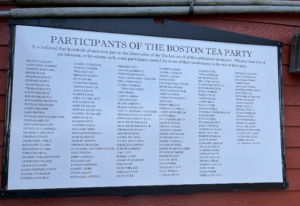

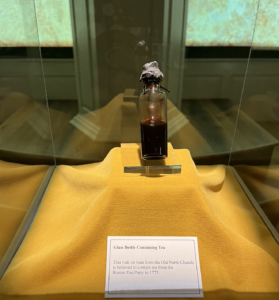
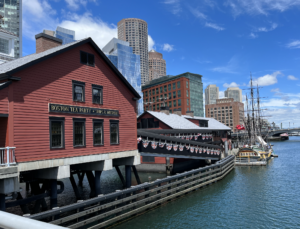
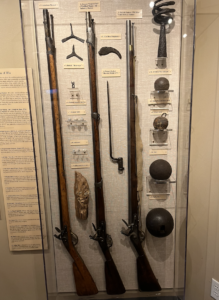
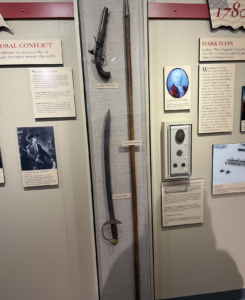


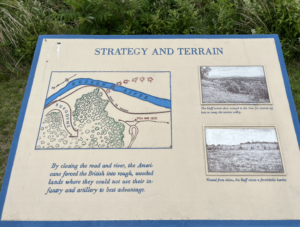





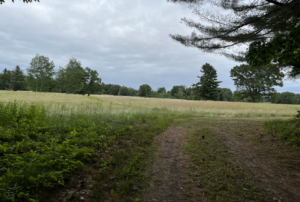
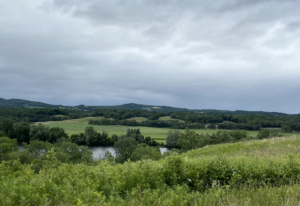
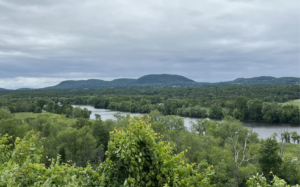








Comments
Best tour report ever!
Well, it ain’t half bad!
I’ve enjoyed all the reports immensely.
I don’t think I read anything about the HMS Gaspee in your trip. Prof. Jacobson should have told you about it and Gaspee Days, celebrated in the quaint village of Pawtuxet, RI, in June. The storming and capture of the HMS Gaspee preceded the Tea Party and is worth remembering and celebrating.
Regardless, thanks for documenting your trip. Except for the parking/towing incident (also worthy of a rebellion some might say) it sounds like a great history tour.
There is a vast difference between the Tea Party and the sacking of the HMS Gaspee. The Browns and all were smugglers and that was piracy. After pouring all of the tea overboard, the “Mohawks” swept up after themselves…. sort of like a MAGA meeting.
May I recommend Bunker’s “An Empire on the Edge: How Britain Came to Fight America” which is the British look at the events leading up to The Revolution. This includes the Gaspee. All that the colonies wanted were to be “British” and be represented in Parliament as equals. All that Washington wanted was a commission as a British officer. Of course the Browns wanted to be left alone to smuggle.
There are reasons to believe General Howe had sympathy for the Americans. That didn’t translate well at Bunker Hill but Howe leaving Burgoyne to his folly may have been. The militia and Benedict Arnold were standouts.
I wish I had copied down the assessment of the Colonial defenses at Bunker made by a British Marine officer who didn’t think much of the Americans. Bunker Hill was a meat grinder. a pyrrhic victory. As in “The Patriot”, Americans shot to kill and that especially targeted officers. Very “unsporting” but very decisive as at Saratoga.
The “Mohawks” also remitted payment for the tea but not for the taxes. Everyone was happy except King George III.
It’s more than just sad that the area of the country that gave us the antidote to tyranny has since embraced it.
I feel like I’m not only with you on your trip, but have musket in hand fighting the British
I lived in Northeastern Pennsylvania where many families had their ancestor’s Revolutionary musket…. the ones most cherished had blood stains on the stock from blood having dripped down from the bayonet.
Mary and all
Thought you might be interested. Sad…
https://www.americanthinker.com/articles/2022/06/colonial_williamsburg_follows_disneys_lead.html
That link shows how the LBG+ has infiltrated the colonies trying to rewrite history
The gay way
I was lucky in Boston when my plane to Aruba was delayed due to weather. Stayed the night and saw a brochure for a trolly ride around Boston the next day. Wow! Bunker Hill, Old North Church, The Constitution (boy its small). Even stopped at a museum that had an Ansel Adams exhibit. Well worth the delay.
Special place in my heart for The Battle of Bennington. My ancester marched there with Gen Stark and later joined Ethan Allen. His grave is in Wilton, NY with a Revolutionary Flag Marker.
“Turns out the last parking spot does not belong to the AirBnB building I used so my car got towed.”
Welcome to Boston!
Mini K and I did the Tea Party museum last year. It was a blast. Loved it. She loved throwing the tea into the harbor and made faces at all of the tea during a tea tasting (which I loved).
The tea partiers “disguised” themselves as Mohawks because they were the nearest member of the Iriquois federation, a democratic alliance of several northeastern native tribes. A symbol of freedom and self-governance.
After Saratoga, Benedict Arnold felt, justifiably or not, that he had done most of the work, and taken most of the risk, while Gates got all of the glory. That and some other slights from his superiors was part of what motivated him to face/heel turn.
Thomas Jefferson was in France for most of the war, trying to secure foreign support for the colonies and against Britian. Once news of Saratoga reached Europe, that solid victory was what finally got the French (and to a lesser extent, the Spanish) off the fence for a chance to take a bite at the growing British empire.
Had Britain chosen to fight on post-Yorktown, we might very well have had World War I a century-and-change early.
The “War on the American Colonies” was very unpopular in the British Parliament and King George III was still debilitated with his “madness” ailment. Yorktown was the last straw. Britain was going broke and needed the colonies. They figured once the patriotic zeal faded away, they would come back and finish the job. It wasn’t until the War of 1812 that the British removed their navy from the Great Lakes which was a key point in the Paris surrender treaty.